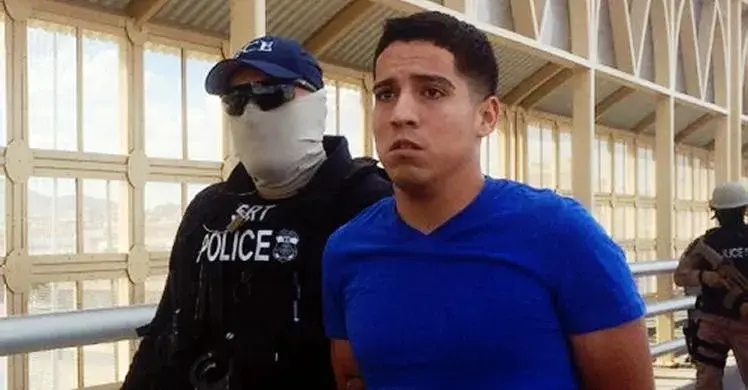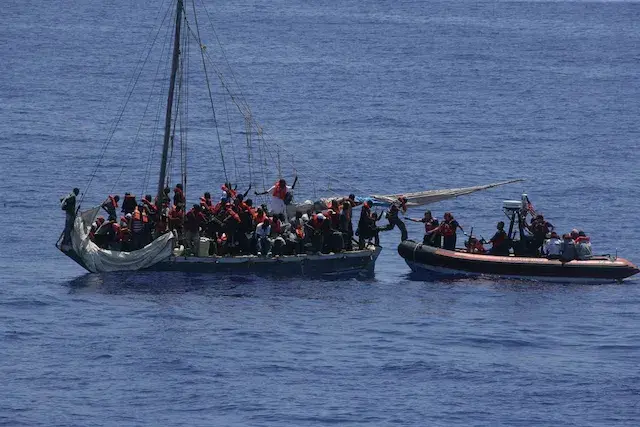By land, sea, and air, dangerous individuals attempt to illegally enter the United States every day. Explore how DHS detects and removes those who pose the biggest threat to our national security.
Bridge of Curly Fries 
Uniformed authorities from two different countries walk toward one other on a bridge that joins the two. When they meet in the middle, a dangerous criminal is transferred from one side to the other. This isn’t the final scene of Bridge of Spies, but it is the final scene of America’s involvement in the story of Cesar Vega-Muñoz.
The story begins once upon a time in Juarez, Mexico with a man named Natividad Terres Leyva. Just after dawn on September 14, 2009, Leyva, a local businessman, is confronted at gunpoint outside of his home. His assailants demand he get into their vehicle. He refuses. But these aren’t the type who take “no” for an answer. They are members of El Neto, Mexico’s most notorious kidnapping ring. In response to Leyva’s defiance, one of the eight men points his gun at Leyva’s wife. Seeing no choice, Leyva reluctantly enters his violator’s vehicle.
Thus began an overnight ordeal for Mr. Leyva that culminated in a tragic ending. El Neto’s purpose isn’t political or in peddling drugs; it’s in profiting off the ransoms extracted from families with the means to pay to get their loved ones back. Vega-Muñoz, then known as “El Chilin”, 22, was the gang’s chief ransom negotiator. His opening price was $47,000. He finally settled for a paltry $700, a television set, and a 2008 Toyota. The deal was done, but the gang wasn’t done abusing Mr. Leyva. They shot him four times that afternoon, then forced him to endure the night in agony before returning him to his family the next day. He barely made it a month before succumbing to his wounds on October 21.
Not long after Mr. Leyva’s release from his captors, Mexican authorities arrested Vega-Muñoz for his role in the kidnapping. He was sentenced to 42 years. However, in December 2010 while being transferred from Cereso Prison to a court appearance, his transport was ambushed. Ever the consummate opportunist, he escaped into the fog of the fire fight.
He made his way to the U.S. border, hoping to cross and flee justice. This would be his second such attempt. His first was unsuccessful. Earlier in 2009 he had tried to enter the U.S. via the Ysleta Port of Entry using someone else’s entry documents. The illegal entry attempt was easily caught by U.S. Customs and Border Protection’s (CBP) Border Patrol Agents, and he was deported back to Mexico that April.
This time around, Vega-Muñoz was successful in his attempt to enter the U.S. He was able to evade detection for nearly a year, taking up illegal residence in Socorro, Texas, where he worked as a fry cook at a local fast food joint. It’s at this time that U.S. Immigration and Customs Enforcement’s (ICE) Enforcement and Removal Operations (ERO) got involved with the case. ERO works with ICE Homeland Security Investigations (HSI), as well as our U.S. consular offices overseas and Interpol to identify foreign fugitives illegally present in the United States. Through this working group, ERO developed information that led to the identification and location of Vega-Muñoz. On December 27, 2011, in front of his drumstick dining establishment, HSI agents took him into custody.
In January 2012, he was charged with and convicted of illegally re-entering the country after deportation—a penalty that can result in a 20-year prison sentence followed by being returned to his country of origin. Still wanted in Mexico for the kidnapping and his escape, ERO coordinated with the Mexican authorities to see that this dangerous individual was removed from the United States.
Atop the Stanton International Bridge Port of Entry on September 14, 2015—6 years to the day after he kidnapped Natividad Terres Leyva—Vega-Muñoz, now 27, was removed from the United States and returned to Mexico where he once again faces justice for his spate of crimes.
ICE ERO coordinates the removal from the United States of criminals, foreign fugitives and others who pose the biggest threats to national security, border security and public safety. In 2014 alone, over 315,000 such individuals were removed thanks to their efforts.
DHS Components and Offices Involved
Dire Straits in the Straits of Florida 
Imagine taking your first true vacation in years. You’re laying out, tall drink in hand, on the top deck of a cruise ship in the Caribbean. Under the balmy sun and between sips, you survey in your surroundings. All the usual suspects are present: people on loungers in food comas brought on by buffets, the obligatory reggae band, kids thrilled to be thrashed about by the wave pool. But what really catches your eye is something you had not expected to see: a dingy raft filled precariously to the brim with people floating listlessly not far from your ship.
This is exactly what happened to a passenger on a Carnival cruise ship in early May 2015. The ship was sailing in waters between Cuba and Dry Tortugas, a 19th century American naval fort located near the Florida Keys. The raft was sailing in the opposite direction—toward Florida. When the passenger spotted the overcrowded, barely seaworthy craft of migrants, she alerted authorities on the ship, who alerted the U.S. Coast Guard.
The U.S. Coast Guard (USCG) is the Nation’s primary maritime law enforcement agency. As such, it is tasked with enforcing immigration law at sea. More importantly, however, USCG’s chief concern is in preventing the loss of life at sea. Given the observed condition of the makeshift craft, it was only a matter of time before lives would be in jeopardy. USCG had to act, and act quickly.
Coast Guard immediately dispatched the Charles David Jr., a 154-ft fast response cutter, to intercept the craft. When they arrived, they quickly realized how perilous the predicament of the migrants was. The craft was clearly homemade. Rafts such as these typically have no lighting, no navigation equipment, and rarely are they stocked with any lifesaving equipment—thus, making any successful crossing of the 90 miles of shark-infested waters to from Cuba to Florida more up to chance than circumnavigation.
All 27 migrants found aboard were safely transferred to the Coast Guard cutter, where they were provided food, water, proper shelter and basic medical care. But Coast Guard soon realized their job wasn’t yet finished.
Another craft with 15 Cuban migrants aboard was spotted the same day not far from the first. Then, two days later, as the cutter was en route to Cuba to repatriate those found at sea, a third craft was spotted. This one carried 8, and was found relatively close to the Port of Matanzas in Northern Cuba.
In all, the 50 migrants Coast Guard interdicted left on separate boats the weak prior from Bahia de Cabañas, a bay in Northern Cuba. On May 13, 2015, a week after their initial spotting from the cruise ship, the cutter Charles David Jr. arrived at the same port from where the migrants originated, and all were repatriated back to Cuba.
For the last two years, USCG has seen a marked increase in the number of migrants originating from Cuba attempting to reach U.S. shores. Since October 2015, the Coast Guard has picked up 2,460 Cubans trying to reach the United States by sea. In 2014, the figure was 3,677, up from 2,129 the year before and 1,870 in 2012.
There are two reasons for the recent uptick. The first is that many Cubans wishing to make the journey believe that as U.S.-Cuba relations normalize, Congress will move repeal the so-called “Wet Foot, Dry Foot” law. The law allows most Cubans who make it onto land in the United States to remain, but those intercepted in U.S. territorial waters are to be returned to Cuba. The second reason is that the breakout of civil conflict and drug cartel-related atrocities in Central America have effectively blocked the land route to America.
Cubans aren’t alone, either. Haitians, Dominicans, and thousands of others originating from around the world attempt to reach the U.S. each year via sea routes. Through its coordination with Federal and international partners, as well as a safety-first approach, the U.S. Coast Guard upholds the nation’s immigration laws while preventing maritime migration tragedies.
